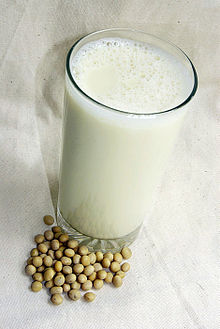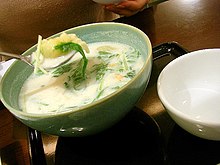Soy milk
 | |||||||
| Alternative names | Soya milk | ||||||
|---|---|---|---|---|---|---|---|
| Place of origin | China | ||||||
| Invented | c. 1365[1] | ||||||
| 33 kcal (138 kJ) | |||||||
| |||||||
| Glycemic index | 34 (low) | ||||||
| Soy milk | |||||||||||||||||
|---|---|---|---|---|---|---|---|---|---|---|---|---|---|---|---|---|---|
| Chinese name | |||||||||||||||||
| Traditional Chinese | 豆漿 | ||||||||||||||||
| Simplified Chinese | 豆浆 | ||||||||||||||||
| Literal meaning | "bean purée" | ||||||||||||||||
| |||||||||||||||||
| Korean name | |||||||||||||||||
| Hangul | 두유 | ||||||||||||||||
| Hanja | 豆乳 | ||||||||||||||||
| Literal meaning | "bean milk" | ||||||||||||||||
| |||||||||||||||||
| Japanese name | |||||||||||||||||
| Kanji | 豆乳 | ||||||||||||||||
| Kana | とうにゅう | ||||||||||||||||
| |||||||||||||||||
Soy milk (also spelled soymilk) is a plant based drink produced by soaking dried soybeans and grinding them in water.
A traditional staple of East Asian cuisine, soy milk is a stable emulsion of oil, water and protein. Soy milk can be produced at home using a soy milk machine. It is often used as a substitute for dairy milk for individuals who are vegan or lactose intolerant.[2]
History
Soy milk (doujiang) originated in China, probably during the early Han dynasty (202 BCE to 9 CE), after the rotary millstone was introduced and became widely used to grind wheat.[3]: 51–52 It did not become widely used in China until the 1800s, when it was discovered that extended heating made it taste better and easier to digest.[3]: 52
John Harvey Kellogg patented[4] a version of soy milk with acidophilus for his sanitarium patients. It was sold commercially in the United States until the 1950s.[5]
Soy milk was re-introduced to the US market by Vitasoy in 1979; the first domestic manufacturer of soy milk was Sunrich Food Group, which introduced its products in 1985.[6]
Name variations
This section needs additional citations for verification. (February 2017) |
There is a certain amount of confusion prevalent when it comes to beverages named soy beverage, soy drink or soy milk respectively. This is caused by several factors:
- The agricultural traditions or laws[7] in many countries require that only milks sourced from certain lactating animals are legally allowed to be named milk when sold commercially. Often only cow's milk is allowed to be named milk on the packaging, and any other milks must state the name of the respective animal, such as goat milk or sheep milk. This leads the manufacturers of plant milks to name their products beverage or drink instead.
- In some countries, soy milk has been named soy bean beverage or soy drink for centuries, and the native population may not respond well to Western influence over the naming of their own traditional heritage foods. Therefore, a preference or competition of soy drinks versus soy milks may exist.
Nutrition


| Nutritional content of cows', soy and almond milk | |||
|---|---|---|---|
| Cows' milk (whole, vitamin D added)[8] |
Soy milk (unsweetened; calcium, vitamins A and D added)[9] |
Almond milk (unsweetened)[10] | |
| Calories (cup, 243 g) | 149 | 80 | 39 |
| Protein (g) | 7.69 | 6.95 | 1.55 |
| Fat (g) | 7.93 | 3.91 | 2.88 |
| Saturated fat (g) | 4.55 | 0.5 | 0 |
| Carbohydrate (g) | 11.71 | 4.23 | 1.52 |
| Fibre (g) | 0 | 1.2 | 0 |
| Sugars (g) | 12.32 | 1 | 0 |
| Calcium (mg) | 276 | 301 | 516 |
| Potassium (mg) | 322 | 292 | 176 |
| Sodium (mg) | 105 | 90 | 186 |
| Vitamin B12 (µg) | 1.10 | 2.70 | 0 |
| Vitamin A (IU) | 395 | 503 | 372 |
| Vitamin D (IU) | 124 | 119 | 110 |
| Cholesterol (mg) | 24 | 0 | 0 |
In a 100 ml (gram, g) serving, one commercial, nutrient-fortified brand of soy milk provides 80 calories from 4 g of carbohydrates, including 1 g of sugar, 4 g of fat and 7 g of protein.[9] This processed soy milk contains appreciable levels of vitamin A, B vitamins and vitamin D in a range of 10 to 45% of the Daily Value, with calcium and magnesium also in significant content.[9] It has a glycemic index of 34±4.[11]
Taste
Soy milk flavor quality differs according to the cultivar of soybean.[12] Soy milk aroma, smoothness and thickness in the mouth, color and creamy appearance are considered desirable qualities, with favored sensory attributes associating with protein content, soluble solids, and oil content.[13]
In a study of taste attributes, soy milk flavored with vanilla or sweet aromatic flavors and higher viscosity was preferred by most subjects, while dislike factors were bean or broth flavors.[14] In another study, 54% of participants preferred the taste of cow's milk, while 27% preferred soy milk, with sweetness and cream qualities identified as important flavor preferences.[2]
Preparation
This section needs additional citations for verification. (June 2016) |
Soy milk is made from whole soybeans or full-fat soy flour.[15] The dry beans are soaked in water overnight or for a minimum of 3 hours or more depending on the temperature of the water. The rehydrated beans then undergo wet grinding with enough added water to give the desired solids content to the final product which has a protein content of 1–4%, depending on the method of production.[15] The ratio of water to beans on a weight basis is 5:1 for traditional soy milk or 20:1 for soy beverages.[15] The resulting slurry or purée is brought to a boil in order to improve its taste properties by heat inactivating soybean trypsin inhibitor, improve its flavor, and to sterilize the product. Heating at or near the boiling point is continued for a period of time, 15–20 minutes, followed by the removal of insoluble residues (soy pulp fiber or okara) by filtration.[15]
Processing requires the use of an anti-foaming agent or natural defoamer during the boiling step. Bringing filtered soy milk to a boil avoids the problem of foaming. It is generally opaque, white or off-white in color, and approximately the same consistency as cow's milk.[15]
Soy milk is also used to manufacture soy yogurt and soy ice cream.[15]
Cooking


Soy milk is found in many vegan and vegetarian food products and can be used as a replacement for cow's milk in many recipes.
"Sweet" and "salty" soy milk are both traditional Chinese breakfast foods, served either hot or cold, usually accompanied by breads like mantou (steamed rolls), youtiao (deep-fried dough), and shaobing (sesame flatbread). The soy beverage is typically sweetened by adding cane sugar or, sometimes, simple syrup. "Salty" soy milk is made with a combination of chopped pickled mustard greens, dried shrimp and, for curdling, vinegar, garnished with youtiao croutons, chopped scallion (spring onions), cilantro (coriander), meat floss (肉鬆; ròusōng), or shallot as well as sesame oil, soy sauce, chili oil or salt to taste. Soy milk is used in many kinds of Japanese cuisine, such as in making yuba as well as sometimes a base soup for nabemono. In Korean cuisine, soy milk is used as a soup for making kongguksu, cold noodle soup eaten mostly in summer.
Soy milk is also used in making soy yogurt, soy cream, soy kefir and soy based cheese analogues.
Ecological impact
Using soybeans to make milk instead of raising cows may be ecologically advantageous.[16] Cows require much more energy in order to produce milk, since the farmer must feed the animal, which can consume up to 24 kilograms (53 lb) of food in dry matter basis and 90 to 180 litres (24 to 48 US gal) of water a day, producing an average of 40 kilograms (88 lb) of milk a day. Legumes, including the soybean plant, also replenish the nitrogen content of the soil in which they are grown.
The cultivation of soybeans in South America is a cause of deforestation[17] (specifically in the Amazon rainforest) and a range of other large-scale environmental harm.[18] Although the argument can be made that the majority of soybean cultivation worldwide, especially in South America where cattle farming is widespread, is intended for livestock fodder rather than soy milk production.[17]
See also
- List of soy-based foods
- Milk substitute
- Plant milk
- Soy milk maker
- Soy yogurt
- Tofu (soy milk curd)
- Tofu skin
References
- ^ "History of Soymilk and Other Non-Dairy Milks (1226-2013)". Soyinfo Center, Lafayette, CA. 2016. Retrieved 15 October 2016.
Yiya Yiyi [Remnant Notions from I Ya], 1365, by Han Yi is the earliest document seen that mentions soymilk, which it calls doufujiang
- ^ a b Palacios, O.M.; Badran, J.; Drake, M. Anne; Reisner, M.; Moskowitz, H.R. (2009). "Consumer acceptance of cow's milk versus soy beverages: Impact of ethnicity, lactose tolerance and sensory preference segmentation". Journal of Sensory Studies. 24 (5): 731–748. doi:10.1111/j.1745-459X.2009.00236.x. ISSN 0887-8250.
- ^ a b H.T. Huang, "Early Uses of Soybean in Chinese History. Chapter 2 in The World of Soy, eds Christine M. Du Bois, Chee-Beng Tan, and Sidney Mintz. University of Illinois Press (August 4, 2008) ISBN 978-0252033414
- ^ US Patent No. 1,982,944, December 4, 1934
- ^ Dr. John Harvey Kellogg and Battle Creek Foods: Work with Soy by William Shurtleff and Akiko Aoyagi
- ^ Soyfoods Association of North America History of Soy Products
- ^ "EUR-Lex - 32013R1308 - EN - EUR-Lex". EURL-Lex. European Union. 20 December 2013. Retrieved 10 April 2017.
"Milk" means exclusively the normal mammary secretion obtained from one or more milkings without either addition thereto or extraction therefrom.
- ^ "Milk, whole, 3.25% milkfat, with added vitamin D", United States Department of Agriculture, Agricultural Research Service.
- ^ a b c "Soymilk (all flavors), unsweetened, with added calcium, vitamins A and D", United States Department of Agriculture, Agricultural Research Service.
- ^ "Beverages, almond milk, unsweetened, shelf stable", United States Department of Agriculture, Agricultural Research Service.
- ^ Atkinson, Fiona S.; Foster-Powell, Kaye; Brand-Miller, Jennie C. (2008-12-01). "International Tables of Glycemic Index and Glycemic Load Values: 2008". Diabetes Care. 31 (12): 2281–2283. doi:10.2337/dc08-1239. ISSN 0149-5992. PMC 2584181. PMID 18835944.
- ^ Shi, X; Li, J; Wang, S; Zhang, L; Qiu, L; Han, T; Wang, Q; Chang, S. K.; Guo, S (2015). "Flavor characteristic analysis of soymilk prepared by different soybean cultivars and establishment of evaluation method of soybean cultivars suitable for soymilk processing". Food Chemistry. 185: 422–9. doi:10.1016/j.foodchem.2015.04.011. PMID 25952888.
- ^ Ma, L; Li, B; Han, F; Yan, S; Wang, L; Sun, J (2015). "Evaluation of the chemical quality traits of soybean seeds, as related to sensory attributes of soymilk". Food Chemistry. 173: 694–701. doi:10.1016/j.foodchem.2014.10.096. PMID 25466078.
- ^ Lawrence, S. E.; Lopetcharat, K; Drake, M. A. (2016). "Preference Mapping of Soymilk with Different U.S. Consumers". Journal of Food Science. 81 (2): S463–76. doi:10.1111/1750-3841.13182. PMID 26677062.
- ^ a b c d e f Berk Z (1992). "Soymilk and related products". Food and Agriculture Organization of the United Nations, Rome, Italy; Corporate Document Repository: Technology of Production of Edible Flours and Protein Products from Soybeans. Services Bulletin No. 97, Chapter 8. Retrieved 16 January 2017.
- ^ "Livestock's long shadow - Environmental issues and options; Chapter 2, Livestock in geographic transition" (PDF). United Nations, Food and Agriculture Organization, Rome. 2006.
- ^ a b "Soy is Everywhere". World Wildlife Fund. Retrieved 14 August 2015.
- ^ "Environmental & social impacts of soy". World Wildlife Fund. Retrieved 14 August 2015.


